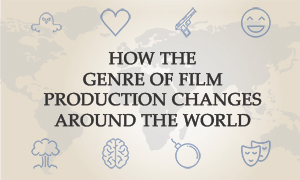 Last week, I shared the results of a research project I conducted into the genre of global film production.
Last week, I shared the results of a research project I conducted into the genre of global film production.
Today, I’m drilling into those numbers to look at how filmmaking tastes change between different countries.
This comes from my dataset of every movie I could find that was produced over the past twenty years – that’s over 117,000 movies from in 151 countries, shot between 1998 to 2017, inclusive.
Let’s start by breaking down the movies into continent of origin and then later we’ll zoom into the individual nations.
Which continent’s filmmakers lead each genre
The chart below shows which continent movies of each genre come from, over the twenty-year period I studied. For example, 50% of all Historical movies made over that time came from European nations. Additional proof that European filmmakers have an above average interest in historical topics comes from the second and third genres they are highest in, which are Biographies and War movies.
Europeans are less keen on Horror movies (only making 22% of all horror movies made), Westerns (21%) and Action movies (19%).
North American filmmakers dominate production of Westerns (accounting for 69% of Westerns), Sci-Fi (57%) and Horror (57%) movies. They’re least dominant in production of War movies, Historical films and Animations.
Their South American neighbours prefer to make Westerns, Biographies, and Musicals. Asian filmmakers are the top producers of Action movies, Animations and Musicals, while African filmmakers have their best showing among Romances, Musicals and films about music. 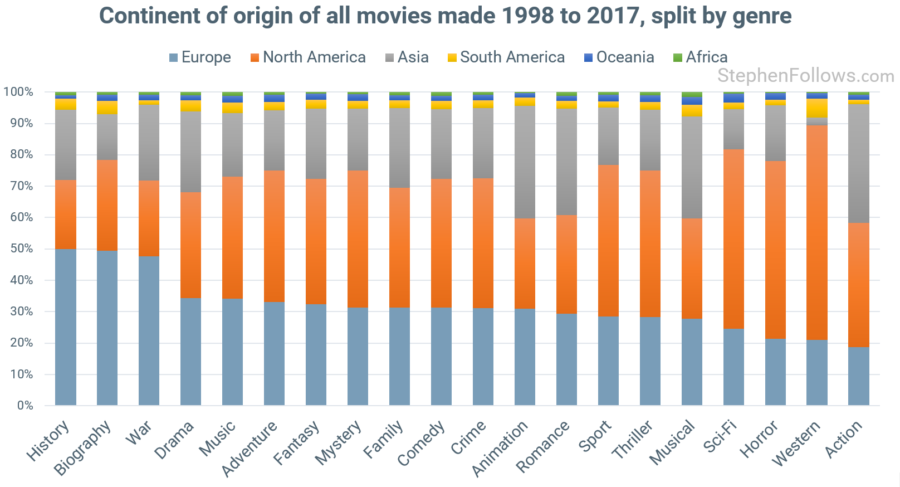 Let’s zoom in further. In order to produce meaningful results, I focused on the fifty largest producing nations over the period (i.e. the countries which made the most films). For each, I looked at what percentage of their movies were Dramas, Comedies, Thrillers, etc.
Let’s zoom in further. In order to produce meaningful results, I focused on the fifty largest producing nations over the period (i.e. the countries which made the most films). For each, I looked at what percentage of their movies were Dramas, Comedies, Thrillers, etc.
For example, 39% of films made in Malaysia over the two decades had Comedy as one of their three genres. The charts in this article show the ten countries with the highest percentage of films within a particular genre, as well as the ten lowest.
So for Comedies, Malaysia ranked third, behind Egypt (whose output was 45% Comedy) and the Czech Republic (40% Comedy).
Drama
Last week, we saw that just over half of all movies have Drama as one of their (up to three) genres. Dramas are most common from filmmakers in Israel, where almost four out of every five movies made is a Drama.
Other dramatic nations include Bulgaria (70% of movies were dramas), Serbia (69%) and Romania (67%). At the other end of the spectrum, only 32% of films from Malaysia are Drama – the lowest of the fifty biggest film-producing countries. 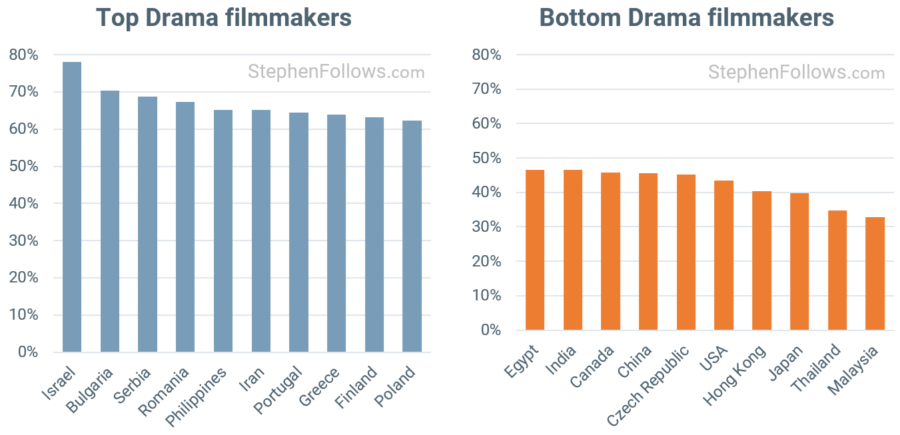
Thriller
Apparently, the UK is the world’s most thrilling film nation – who knew?! So while the rest of the world may see Brits as sedate, tea-drinking talkers, their film output contains the highest percentage of Thrillers of all major film-producing nations.
Other top Thriller-heavy nations include Commonwealth countries such as Australia, Canada and New Zealand (plus the UK’s ex, the USA).
Japan and Iran produce the lowest share of Thrillers, at under 4% each. 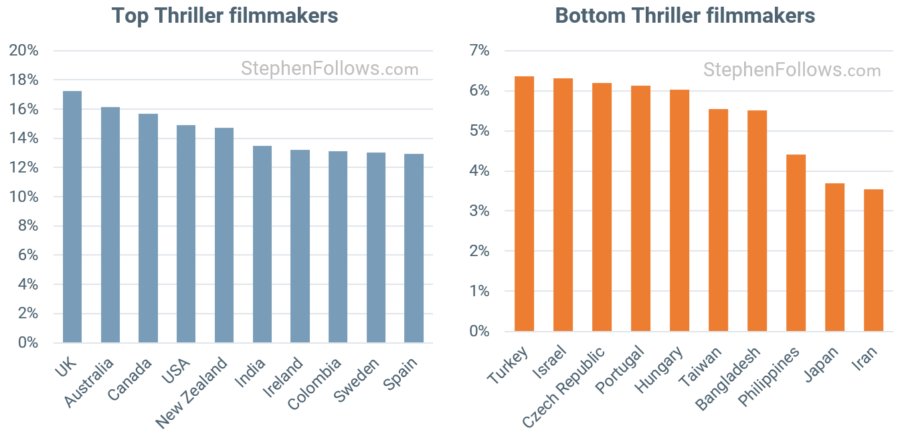
Comedy
45% of Egyptian movies are Comedies, making it the genre’s most committed nation.
At the other end of the spectrum, Iran, Nigeria and Bangladesh don’t seem so keen on producing Comedies. 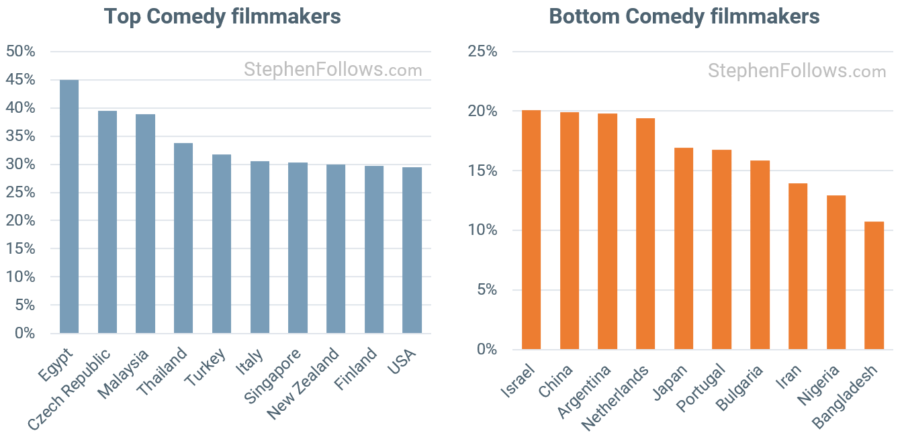
Action
While Bangladeshi filmmakers may eschew Comedy, they love Action, with a third of their movies being action-oriented.
Over a quarter of films from Hong Kong are Action movies, along with a fifth of Indian movies. 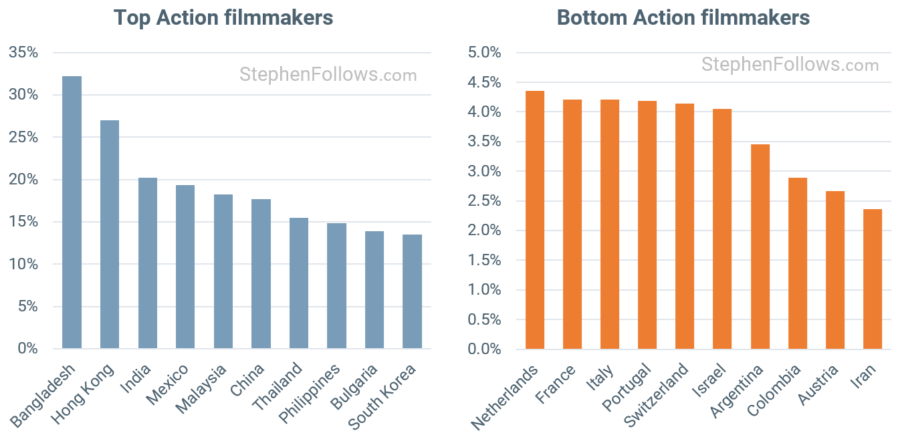
Horror
America is the world’s largest producer of horror movies, by a long shot. But if instead of looking at the volume of movies made, we focus on how much of a percentage of their total film output are Horror movies, they’re fourth behind Indonesia, Thailand and Malaysia. 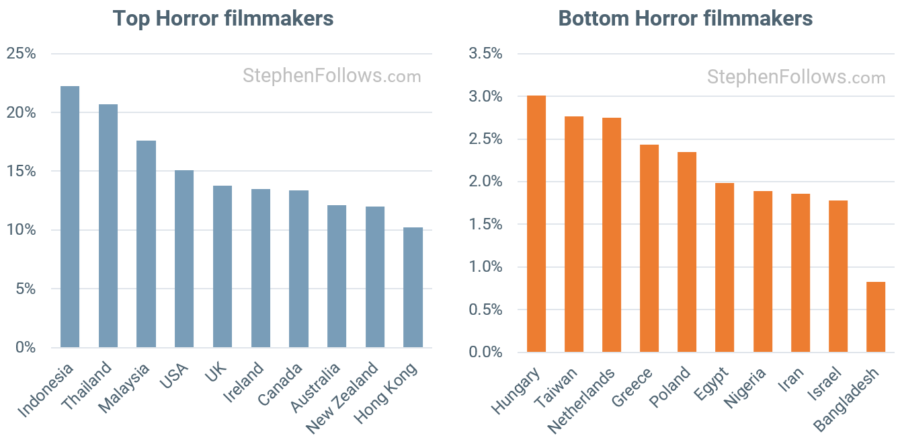
Fantasy
If six Lords of the Rings movies weren’t enough of a clue, New Zealand is the home of Fantasy filmmaking. Almost 10% of all movies made in New Zealand over the twenty years I studied were Fantasy movies. 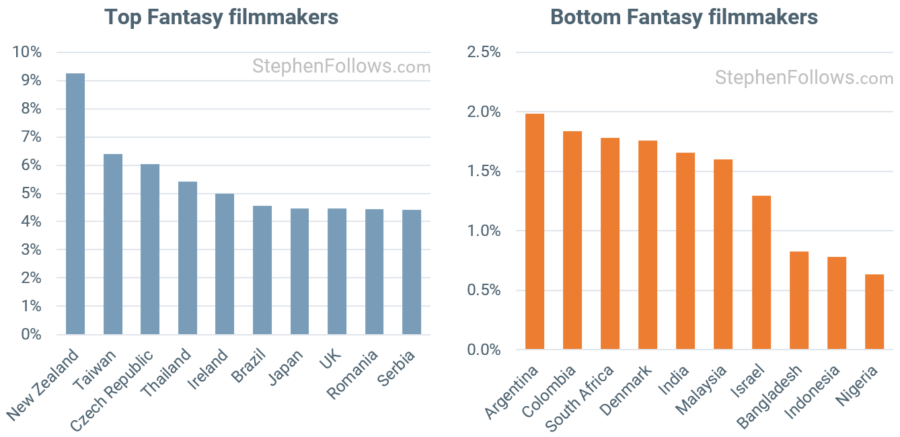
History
As we saw at the start, European nations feature very highly among the biggest producers of historical movies. 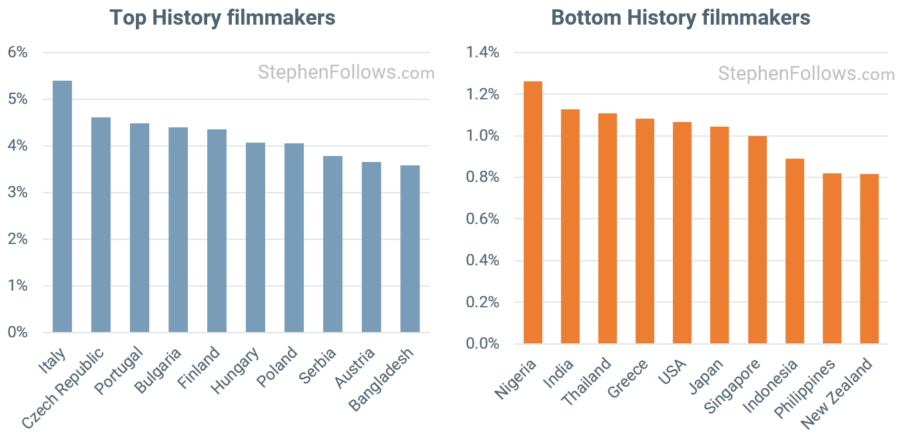
Notes
The data for today’s article came from a variety of sources, including IMDb, Wikipedia and Movie Insider. This research is focused on fiction feature films (so not short films, TV movies, documentaries, etc) and includes all movies produced, not just those that were released in cinemas. I allowed each movie to have up to three genres, which was derived as an aggregate of all the sources listing that movie.
Across the dataset, the average movie had 1.7 genre classifications. The 20 genres I included were Action, Adventure, Animation, Biography, Comedy, Crime, Drama, Family, Fantasy, History, Horror, Music, Musical, Mystery, Romance, Sci-Fi, Sport, Thriller, War and Western.
For the notes referring to continents, I counted the following countries as in both Europe and Asia: Russia, Turkey, Kazakhstan, Georgia, Armenia and Azerbaijan.
It’s worth noting that we’re measuring production numbers, not amount spent, meaning that a micro-budget film has the same weight as a mega-studio tentpole. This instinctively feels like a better measure of a nation’s filmmaking tastes, as otherwise a country could make 660 micro-budget dramas and play host to one Hollywood action film and the nation’s output would be classed as “50% action movies”.

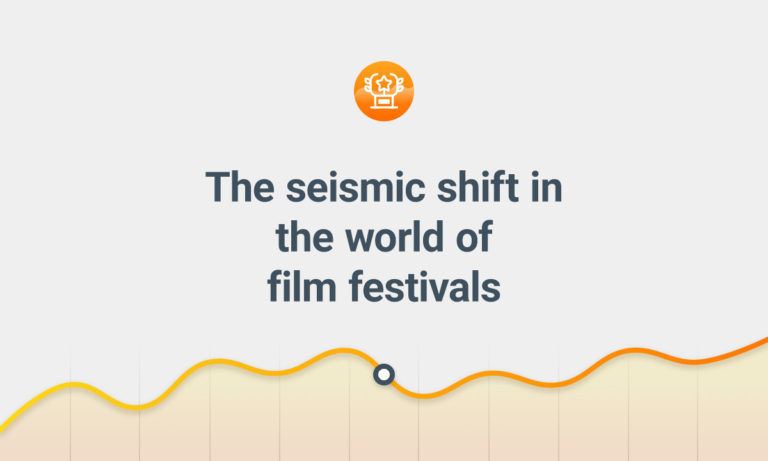
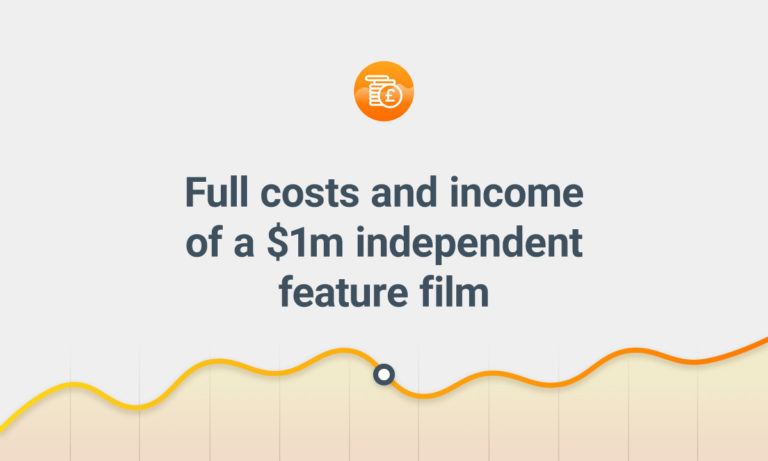


Comments
Very interesting. Thank you very much.
Think there’s a slight error in one of your statements about thrillers in the bottom range. Surely you meant Japan and Iran are under 4%, given that you’ve shown Canada high up, just behind the UK, in the graph on the left…?
Great stuff, anyway!
Hello Stephen
You have been working very hard with great and useful results
“Their South American neighbours prefer to make Westerns (…)”
This can’t be right.
Hi Lucas. It is right, but I understand why it may sound strange! The data doesn’t say that say that South American filmmakers make a large number of Westerns, but rather that of all Westerns made in the world, a not-insignificant proportion of them are made by South American filmmakers.
A way of wrapping your head around it would be to imagine who do you picture makes Westerns? The North American filmmakers make the vast majority but who would you expect to come second? European, Asian and African nations don’t have the Western myth in their culture, in their history or (perhaps crucially) with interactions with their neighbours.
Hope that helps
Thanks, Stephen! Always great infos.
How much do you know about the films produced in Argentina by Argentineans? Or Brazil or Uruguay? Or Chile? Just the ones that brought Oscars home and the dozens nominated for that. Which one of those was a western? Thanks
Hi Sebastian. No, I don’t know much about them individually. I’m not sure what you point is with award-nominated films. This research looks at the volume of production, not the success of the best a country has to offer.
Remember, we’re not necessarily dealing with a lot in raw numbers, just a lot proportionally to the number made worldwide. For example, in the past decade, IMDb lists 19 Argentinan Westerns. Compare that with Russia, a country with over three times the population and who produce a roughly similar number of films, and it was just one.
very enlightining your posts are ! I wish you could do a Brazil moviemaking study…
there is a myth that only movies that are grit with poverty and slum based drug dealers
or some awareness based storytelling may do well from brazillians…
although the soap operas from Globo Tv export everywhere, moviemaking here is locked
in a post-cinema novo view. in a closed circle kind of thinking: only comedies do tickets
so lets do more comedies…
another travelogue to discovery would be a storical study of jackie chan movies
for those are a ‘path’ that might be a good blue print.
meanwhile, cheers from Rio.
As always, interesting stuff Stephen, thanks for all your hard work. Is it possible to get a drop of the actual numbers behind the charts in respect of Australian films (ie #films by your 20 genres)?
Do you mind if I ask how you accessed this data? I’m a film historian relatively new to data analysis and would be interested to know how you sourced these datasets from Wikipedia and how accurate they are/what the limitations might be. Only if you have the time, of course!
Hi Laura
It’s a database I’ve been building for a while from a number of sources.
The limitations would include that it assumes that movies listed in multiple sources are real (i.e. a dedicated faker could get a non-existent film on this list). It also rewards films promoted on English language sites and from people who are at least semi web literate. Very small, niche films will only appear online if someone involved wanted to list them.
Therefore, I can’t say I have every single film, or that I don’t have any false positives. But it’s fair to say that it’s well over 99% correct and that there’s no reason to thing that the very small number of errors would skew the overall results.
Do you have the breakdown for Sci-Fi films, or should I include that in the Fantasy category you have listed?
OK, thanks…
I think you may have skewed these results somewhat by only allowing up to 3 genres per film, at least certainly when it comes to India. The “masala film” commercial tradition intentionally mixes as many genres as possible, so some films from India would have genuinely had upwards of 5 genres or so.
would love to know Indonesian as well since horror and drama is more in production there
enjoying your content. however, I would differ on drama films in India . Most of the films, in all our languages, are drama films.
Is it correct that North America produces the most Westerns? I thought Western was dead! Just checking
Yes, that’s right